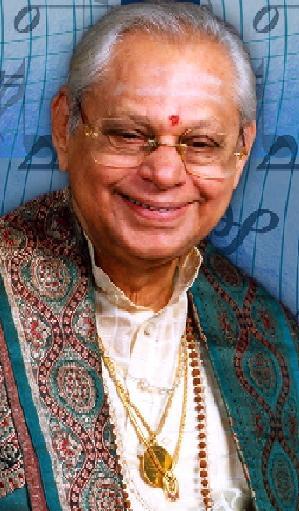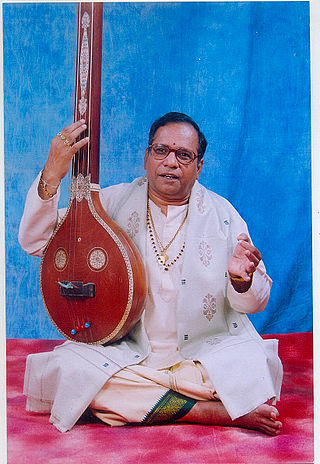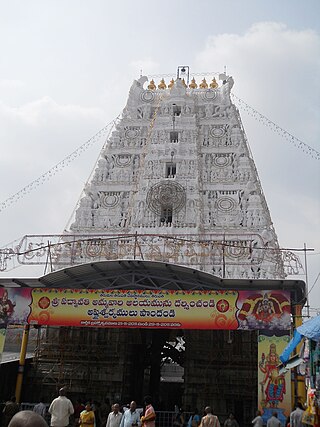
Venkateswara, also known as Venkatachalapati, Balaji and Srinivasa, is a Hindu deity, described as a form or avatar of the god Vishnu. He is the presiding deity of Venkatesvara Temple, Tirupati. His consorts, Padmavathi and Bhudevi, are avatars of the goddess Lakshmi, the consort of Vishnu.

Tirumala Tirupati Devasthanams (TTD) is an independent government trust in India managed by the Government of Andhra Pradesh. The trust primarily oversees the operations and finances of the richest and the most visited religious center Venkateswara Temple, Tirumala. It is also involved in various social, religious, literary and educational activities. TTD is headquartered at Tirupati in Andhra Pradesh, India and employs about 16,000 people.

Tirumala is a spiritual place in Tirupati district of the Indian state of Andhra Pradesh. It is one of the neighbourhoods of the Tirupati city. The town is a part of Tirupati Urban Development Authority and located in Tirupati (urban) mandal of Tirupati revenue division. The town is strictly vegetarian. It is a hill town where Tirumala Venkateswara Temple is located, a popular shrine of Vishnu. Vishnu was considered to reside here with his full power, as in Vaikuntha, and thus the place was also called 'Bhuloka Vaikuntha'.

Annamayya is a 1997 Indian Telugu-language hagiographical film directed by K. Raghavendra Rao and produced by V. Doraswamy Raju under the VMC Productions banner. The film portrays the life of the 15th century composer Annamacharya, played by Nagarjuna Akkineni who features alongside an ensemble cast including Mohan Babu, Suman, Ramya Krishna, Bhanupriya, Roja, and Kasthuri. The film has score and soundtrack composed by M. M. Keeravani. Upon release, the film received positive reviews and won eight Nandi Awards, three Filmfare Awards and two National Film Awards. The film was featured in the Indian panorama mainstream section at the 29th IFFI.

hi all

Tirupati is a city in the Indian state of Andhra Pradesh and serves as the administrative headquarters of Tirupati district. It is known for its significant religious and cultural heritage, being home to the renowned Tirumala Venkateswara Temple, a major Hindu pilgrimage site, as well as other historic temples. The temple is one of the eight Svayam Vyakta Kshetras dedicated to the deity Vishnu. Tirupati is situated 150 km from Chennai, 250 km from Bangalore, and 406 km from Amaravati.

Sri Venkateswara Swami vari Brahmotsavam or Srivari Brahmotsavam or Purattasi Brahmotsavam is the most significant annual fête celebrated at the Venkateswara Temple in Tirumala-Tirupati, Tirupati district, Andhra Pradesh, India. which falls between the Telugu calendar of Aasveeyujamu and the Gregorian calendar months of September or October.

The Venkateswara Temple of Tirumala, called Sri Venkateswara Swami Temple, is a Hindu temple situated in the hills of Tirumala at Tirupati Urban Mandal in the Tirupati district of Andhra Pradesh, India. The temple is dedicated to Venkateswara, a form of Vishnu, who is believed to have appeared on the earth to save mankind from trials and troubles of Kali Yuga. Hence the place is also known by the name Kaliyuga Vaikuntha and the deity here is referred to as Kaliyuga Prathyaksha Daivam. The temple is also known by other names like Tirumala Temple, Tirupati Temple and Tirupati Balaji Temple. Venkateswara is also known by other names including Balaji, Govinda, and Srinivasa. The temple is run by Tirumala Tirupati Devasthanams (TTD), which is under control of Andhra Pradesh Government. The head of TTD is appointed by Andhra Pradesh Government.

Nedunuri Krishnamurthy was an Indian Carnatic vocalist. He was awarded the Madras Music Academy's Sangeetha Kalanidhi in 1991.

Mahamahopadhyaya Dr. Nookala Chinna Satyanarayana was a Carnatic musician, a classical vocalist, musicologist, author and teacher, a great administrator and motivator. He was a performer on All India Radio and Doordarshan who participated in Sangeeta Sammelans, outdoor broadcasts and national programmes innumerable times. His radio lessons and Bhakti Ranjanis were very popular. He was awarded Padma Bhushan award by the Government of India in 2010.

Garimella Balakrishna Prasad is an Indian classical devotional singer, composer, Sangeet Natak Akademi for year 2020, T.T.D Asthana Vidwaan and Ahobhilamatam Asthana Vidwaan. He served Tirumala Tirupati Devastanam's Annamacharya Project as Special Grade Vocal Artiste from 1978 to 2006.

Rallapalli Ananta Krishna Sharma was a noted composer of Carnatic music, singer, Telugu literature, teacher and Sanskrit scholar. He was responsible for discovering and cataloguing many forgotten compositions of Annamacharya. These compositions revived by Sharma would be sung by successive singers like S. P. Balasubramanyam and M. S. Subbalakshmi bringing popularity to the songs.
Pattu Rajagopalan is a former vocal artist of Carnatic music in All India Radio (AIR), Hyderabad and the Annamacharya Project of Tirumala-Tirupati Devasthanams (TTD) in Tirupati, Andhra Pradesh, India.
Shobha Raju is an Indian devotional singer, writer and composer, known as an exponent of sankirtana of the compositions of the saint-composer, Annamacharya. She was awarded the Padma Shri by Government of India for her contributions to arts in 2010. She is the founder of "Annamacharya Bhavana Vahini" (ABV).

Alipiri Padala Mandapam or Alipiri is the place at foot of seven hills in Tirupati, the pilgrim city of Sri Venkateswara Swami, in the state of Andhra Pradesh, India. It is a neighbourhood of Tirupati city.

Padmavathi Temple is a Hindu temple dedicated to the deity Padmavathi (Alamelumanga), the consort of Venkateswara. The temple is situated in Tiruchanur area of Tirupati city in Tirupati district of Andhra Pradesh, India.
Venkateswara Temple is an important Vaishnavite temple situated in the hill town of Tirumala in Tirupati of Andhra Pradesh, India. The Temple is dedicated to Venkateswara, an incarnation of Vishnu, who is believed to have appeared here to save mankind from the trials and troubles of Kali Yuga. The temple is situated at a height of 853 m (2,799 ft) on Tirumala Hills which are part of the Seshachalam Hills and is constructed in Dravidian architectural style.

Kalyana Venkateswara Temple is an ancient Hindu temple at Srinivasamangapuram in Tirupati. It is located in Tirupati District of Andhra Pradesh, India. The temple is dedicated to the god Venkateswara, a form of Vishnu and is referred to as Kalyana Venkateswara. The temple is one of the centrally protected monuments of national importance.
Sri Narapura Venkateswara Temple is an ancient Hindu temple situated in Jammalamadugu, YSR Kadapa District, Andhra Pradesh India. The temple is dedicated to the Hindu god Venkateswara, a form of Vishnu, who is referred to as Narapura Venkateswara. According to the temple history, the temple derives its name from Narapuraiah, a devotee of Venkateswara, who constructed this temple based on what he considered the deity's wishes. Within the main premises of the temple, there is Anjaneya temple, Kalyana Mantapam, and Goshala. The temple has been under the control of TTD since 2008. The temple is generally crowded on Saturdays being it a significant day for Venkateswara.
Venkateswara Temple is an important Vaishnavite temple situated in the hill town of Tirumala in Tirupati district of Andhra Pradesh, built by a Tamil king Tondaiman and later expanded and renovated under the Chola and Vijayanagara Empire. The Temple is dedicated to Lord Venkateswara, an incarnation of Vishnu, who is believed to have appeared here to save mankind from the trials and troubles of Kali Yuga. The temple is situated at a height of 853 metres on Tirumala Hills which are part of Seshachalam Hills and is constructed in South Indian Tamil Architectural Style.


















